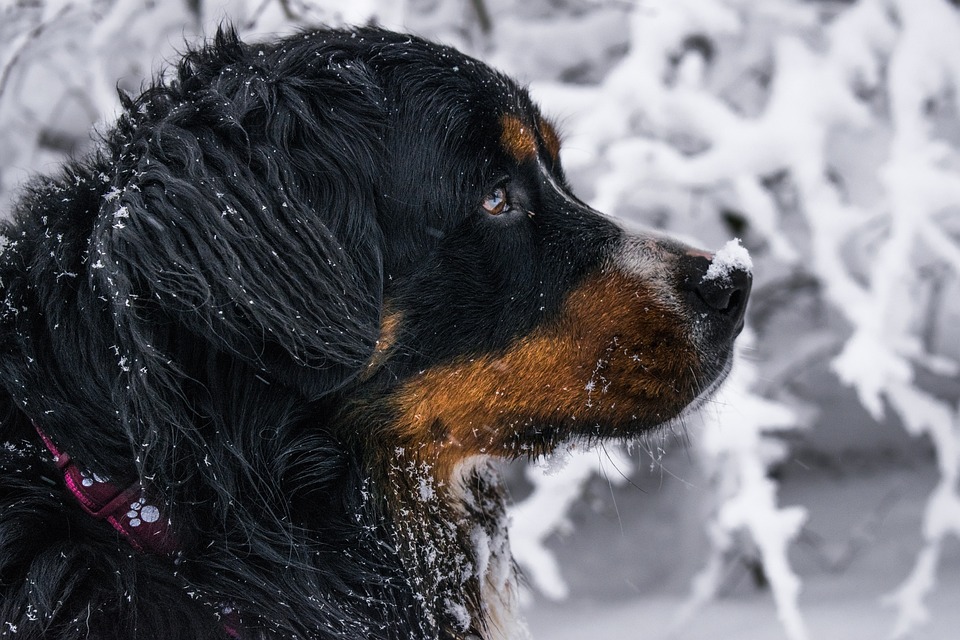
Bernese Mountain Dogs are a hardy, cold-loving breed of dogs but how cold is too cold for them?
Healthy adult Bernese Mountain Dogs do well in cold winter weather but any animal is at risk for frostbite and hypothermia in freezing temperatures. Limit the time outdoors on days colder than 32°F/ 0°C. When it is colder than – 4°F / -20°C, avoid spending more than 15-20 minutes outside. Puppies, old dogs, and ill or deconditioned animals are especially vulnerable to frostbite and hypothermia.
It is important to consider every dog’s characteristics and the breed’s traits overall.
HOW COLD IS TOO COLD FOR A BERNESE MOUNTAIN DOG?
Above 45 °F/ 7°C: Most Berners are hardy enough to tolerate this temperature range without issue.
Below 45 °F/ 7°C: Adult healthy Berner should be fine. Dogs not accustomed to cold weather might start feeling uncomfortable, especially if they stay outdoors for a few hours or due to inactivity.
Colder than 32°F / 0°C: Healthy adult Bernese Mountain Dogs generally do well with going on walks when the temperatures are below the freezing point. However, you should monitor your pet for signs of hypothermia and frostbite.
Below – 4°F / -20°C: Bernese Mountain Dogs can spend some time outside when it is as cold as – 4°F / -20°C. However, they should not be alone when it is that cold. Sleeping outside overnight in such low temperatures is not safe for any dog.
Any precipitation creates conditions under which the double coat could lose its insulating power. So, rain, snow, and hail make your dog more vulnerable. Strong wind has a similar effect.
BERNESE MOUNTAIN DOGS’ ADAPTATIONS TO COLD WEATHER
Thick Double Coat
The Bernese Mountain Dog’s fur is an excellent, thick, water-repellent barrier that effectively insulates the animal. It enables these dogs to thrive in cold climates.
The coat has two layers:
- The undercoat consists of short thick wooly hairs. It insulates the dog, protecting the pup from cold and hot air.
- The upper layer is made of long rough hairs. It repels moisture and insects and shields from UV light in summer.
Other adaptations include the following:
- Paw cushions: The dog’s paws are cushioned with subcutaneous fat and connective tissue and supported by a prolific net of blood vessels. Good blood supply to the paws allows the body to keep them warm and protects them from frostbite. Cold weather causes blood vessels to constrict, so blood supply becomes more limited.
- Piloerection: Dogs get goosebumps. Their hairs stand up and create a pocket of air between hair shafts, which prevents warm air from escaping and cold air from getting close to the skin.
- Slowing of metabolism: Animals’ metabolism is slower in cold weather and they release less energy to their surroundings.
- Shivering: Dogs shiver, which generates heat and keeps them warmer. Shivering is common when the dog is mildly hypothermic but may stop as hypothermia progresses.
Individual Risk Factors for Hypothermia and Frostbite
Several individual characteristics can make a Bernese Mountain Dogs more vulnerable to developing hypothermia and frostbite:
- Lack of general conditioning: dogs that are not in good shape are less resistant.
- Lack of acclimatization: being used to the cold allows an animal to adjust over time.
- Any physical health problem – chronic or acute – puts a dog at risk.
- Old pups are at high risk for hypothermia, because of impaired physiologic responses to the cold.
- Puppies are also less sturdy.
- Wet fur is a risk factor even for young and healthy dogs.
- An inactive dog is prone to cooling down at an accelerated rate.
How to Tell If Your Dog Is Too Cold
As large dogs, Berners have a normal body temperature in this range: 101.5-102.5 °F / 38.5-39.2 °C.
If the dog cools down to 90 – 95 °F / 32-35 °C, the animal is mildly hypothermic.
Temperatures below 84°F / 28 °C signify severe hypothermia.
Some of the common signs of mild and moderate hypothermia include the following:
- Behavioral changes, for example, nervousness, pacing, refusing to walk
- Picking up and holding up a paw
- Hunched back and a curled-up tail
- Vocalizing in a way that communicates distress
- Pale skin
- Shivering
The signs of severe hypothermia are the following:
- Weakness and lethargy
- Stiffness of paws and eventually the torso
- Slow breathing
- Labored breathing
- Slow pulse
- Dilated pupils
If your dog shows any signs of severe hypothermia or you recognize in other ways that your dog is unwell, take your pet to a veterinarian without delay.
Professionals are skilled at gradually raising an animal’s temperature in ways that are safe for the dog. Some animals need respiratory support at that point, which can be provided at a vet’s office.
How to Keep Your Dog Warm
To improve your Berner’s tolerance of cold weather and keep your pet warm on cold days:
- Allow your dog to acclimate if the animal is not used to cold weather. At first, spend short periods in the cold, gradually increasing the time as tolerated.
- Ensure your dog eats well before going outside. Warm food and water are ideal on a cold day.
- It is important to regularly feed your dog good quality food to promote general health and better tolerance to cold weather.
- Let your dog exercise regularly and support graded conditioning.
- Dry your pup’s wet fur as soon as you can.
- Clean the paws of ice and rocks.
- Consider a waterproof warm coat if your dog goes outside in cold weather. It is important to measure your dog, as recommended by the manufacturer, to make sure you are getting the right size.
- Waterproof boots are just as important, especially in icy conditions.
If your dog looks cold but does not appear stiff and confused, the animal might be mildly hypothermic:
- Take him or her home, bundle with blankets, and offer a warm meal and water.
- Avoid using hot items, such as heating pads or hot water bottles directly on the fur or skin, because they will feel too hot, even though the fur, and might cause damage.
FROSTBITE
If a dog is cold for some time, the body constricts peripheral blood vessels to keep the torso warm. The paws and the tail stay colder.
While this adaptation increases the chances of survival, it leaves the paws, tail, and ears particularly at risk for frostbite. Frostbite can affect other parts of the body too.
These are some signs of frostbite:
- pale or gray skin
- coldness of the area
- pain, the dog could guard the affected paw
- swelling and inflammation develop over a few days
- ulcers and blisters are common at later stages
- the area could become discolored, often purple and black if frostbite is severe enough to cause necrosis
- infections of necrotic tissues are common
If you think frostbite might have occurred, do not wait to take your Berner to a veterinarian for an evaluation.
Some animals do not survive frostbite, usually due to secondary infections. So professional treatment is essential to promote a good recovery.
How to Prevent Frostbite
The interventions to keep your dog’s paws safe from frostbite also help prevent damage from chemicals used to de-ice roads and driveways in winter.
Socks Or Boots
A physical barrier, such as dog booties or socks, is the most reliable way to protect paws from frostbite in freezing weather.
Most dogs take time to become accustomed to wearing boots. Have your pup wear them ahead of time for a little bit. If your Berner hates wearing booties, paw balm, or another oil or petroleum-based product might be the next best option.
Paw Balm
Paw balm, or wax, is a great way to protect the paws from cold and hot surfaces.
Beeswax and paraffin are the core ingredients of manufactured paw butter products. These products are designed to seal off the paw and protect it from ice, cold, and chemicals.
Paw balm can be messy when your dog returns home, so cleaning the paws promptly is important.
Petroleum Jelly Products
Purified petroleum-based products are safe for pet paws and could be a cheaper alternative to paw balm products, with similar protective value.
The most commonly used products are Vaseline and Aquaphor. Aquaphor might be a better option because it creates a barrier and moisturizes the paws.
To Conclude
Bernese Mountain Dogs are among the most stoic breeds when it comes to tolerating cold weather but even the hardiest of all should be monitored for hypothermia and frostbite.
An important tool is knowing your pet and recognizing abnormal behavior. If your dog has some physical signs of being cold and acts restless or lethargic, take him or her home to rest and warm up.
Recent Posts
Many people have conflicting feelings about large animals living in apartments and small spaces. However, regular physical activity is more important than a spacious living area. Bernese Mountain...
These dogs are hardy in winter weather but how do Bernese Mountain Dogs do in a hot climate? Do Bernese Mountain Dogs tolerate hot weather? Bernese Mountain Dogs do not tolerate hot weather. Even...

